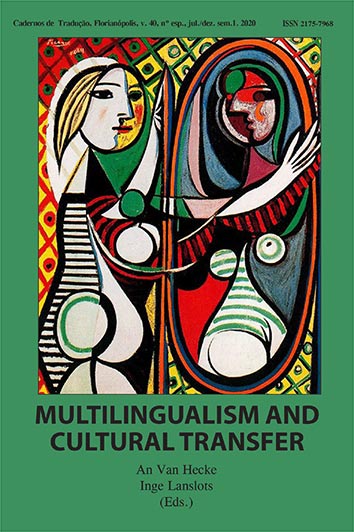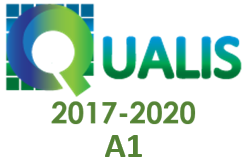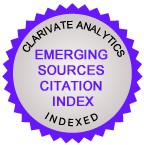“Transito, ergo sum”. Trajectories of narrative identity in Paloma Vidal's self-translation Más al Sur
DOI:
https://doi.org/10.5007/2175-7968.2020v40nespp71Abstract
In Mais ao sul (2008), the Argentinian-Brazilian writer Paloma Vidal collects short stories which evolve around displacement, based upon her own experience of being exiled with her Argentinian parents in Brazil at the age of two. In 2011, she self-translated these stories from Portuguese into Spanish, resulting in Más al sur. In the preface of Más al sur, Vidal underscores that it is not a re-writing, but a translation, hereby reducing her work as a creating author. However, by translating herself, she delved into her trajectory as a migrant and multilingual individual. Taking the concept of narrative identity developed by Paul Ricoeur as a starting point, in this article we aim to investigate how self-translation functions as another phase in the project of morphing of the self which was initiated when writing the original work.References
Anderson, Benedict. Imagined communities: reflections on the origin and spread of nationalism. London: Verso, 2016.
Anselmi, Simona. On Self-translation: An exploration in Self-translators’ Teloi and Strategies. Milano: LED, 2012.
Boyden, Michael; De Bleeker, Liesbeth. “Introduction”. Orbis Litterarum. 68.3, (2013): 177-187.
Cobas Carral, Andrea. “Memoria, temporalidades y voces narrativas en La casa de los conejos de Laura Alcoba”. Afuera. (2012): s/p.
Cordingley, Anthony. Self-Translation: Brokering Originality in Hybrid Culture. London: Bloomsbury, 2013.
Hassan, Waïl S. “Agency and Translational Literature: Ahdaf’s Soueif’s The Map of Love”. PMLA. 3, (2006): 753-768.
Hokenson, Jan; Munson, Marcella. The bilingual text: history and theory of literary self-translation. Manchester, Kinderhook, NY: St. Jerome, 2007.
Kellman, Steven. The translingual imagination. Lincoln: University of Nebraska Press, 2000.
Kosinki, Alejandro. “Una manera de responder ¿quién soy?: la identidad narrativa de Paul Ricoeur”. Avatares filosóficos. 2, (2015): 213-221.
La Capra, Dominick. Historia en tránsito. Experiencia, identidad, teoría crítica. Buenos Aires: FCE, 2006.
Noll, João Gilberto. Berkeley em Bellagio. Rio de Janeiro: Objetiva, 2002.
Oustinoff, Michaël. Bilinguisme d’écriture et auto–traduction: Julien Green, Samuel Beckett, Vladimir Nabokov. Paris: L’Harmattan, 2001.
“Paloma Vidal – Entrevista”. YouTube, subido por Pauliceia Literária, 27 de agosto 2015, www.youtube.com/watch?v=AfYE_1sgv0o.
Pamplona, Juliana. Fora da máquina de lavar. Rio de Janeiro: Casa da Palavra, 2006.
Pérez Firmat, Gustavo. Tongue ties: logo-eroticism in Anglo-Hispanic literature. New York: Palgrave Macmillan, 2003.
Ricoeur, Paul. Sí mismo como otro. Traducción de Agustín Neira Calvo. Madrid: Siglo XXI, 1996.
Santoyo, Julio César. “Traducciones de autor: una mirada retrospectiva”. Quimera. CCX/9, (2002): 27-32.
Seifert, Marcos. “La extranjería como extimidad. Más al sur de Paloma Vidal”. Rassegna iberistica. 37.102, (2014): 283-288.
Yildiz, Yasemin. Beyond the mother tongue: the postmonolingual condition. New York: Fordham University Press, 2012.
Venuti, Lawrence. The translator’s invisibility: a history of translation. NY: Routledge, 1995.
Vidal, Paloma. Mais ao sul. Rio de Janeiro: Lingua Geral, 2008.
Vidal, Paloma. Más al sur. Tradución de Paloma Vidal. Buenos Aires: Eterna Cadencia, 2011.
Downloads
Published
How to Cite
Issue
Section
License
Copyright Notice
Authors hold the copyright and grant the journal the right for their articles' first publication, being their works simultaneously licensed under the Creative Commons Attribution License (CC BY), which allows the sharing of such works with its authorship acknowledged and its initial publication in this journal.
Authors are allowed to enter into separate additional contractual arrangements for the non-exclusive distribution of the journal's published version of the work (e.g., post it to an institutional repository or as a book chapter, with an acknowledgment of its initial publication in this journal).






















































